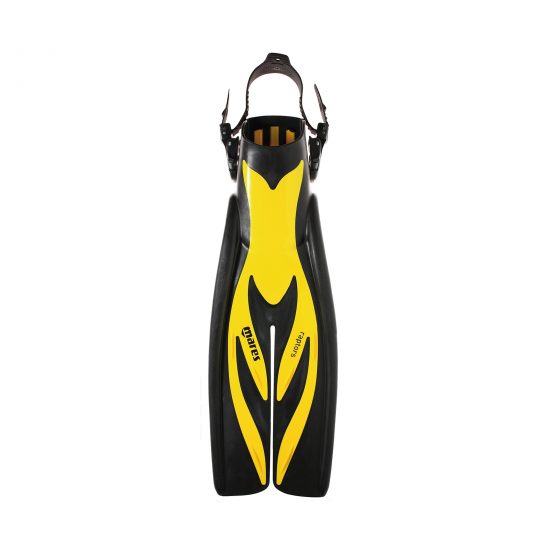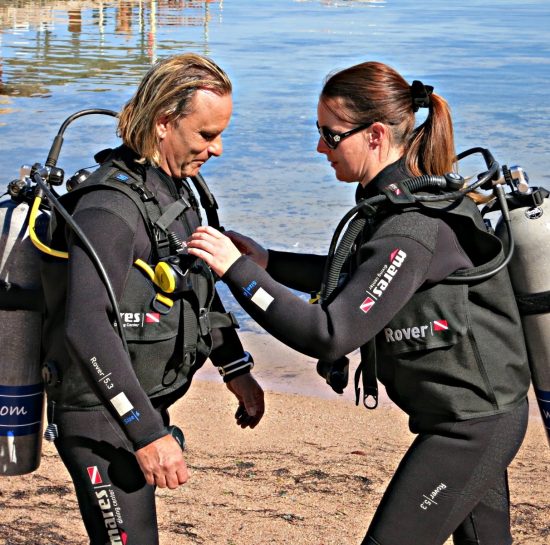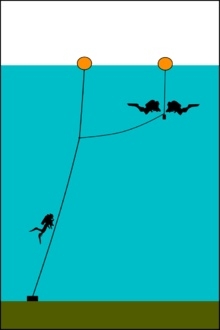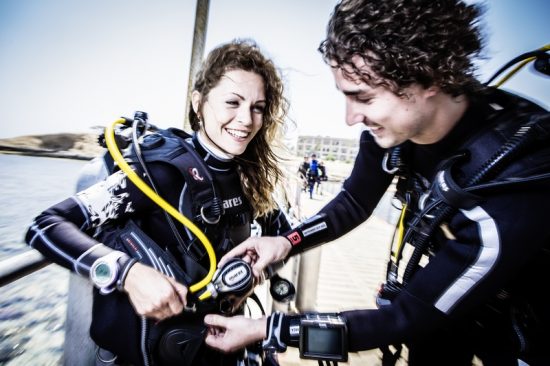






There is nothing more frustrating in life then when you are within a group of individuals who are speaking a foreign language and you struggle to understand the conversation. Trust me, I should know, as a Welsh women trying to communicate with my husband's German family! This is exactly the same situation when you are in the middle of a group of scuba divers. They speak the language of “Scuba” which is a mystery to those who have not tried that particular recreational activity, and maybe a mystery to some scuba divers themselves!
Use my alphabet jargon guide to help you establish some basic scuba language skills so you are not left completely in the dark and can impress your companions with your knowledge of their chosen sport!
A = Ali 80
This is the typical reference to a common size and material of a scuba diving cylinder. The material of the tank is made from aluminium and the size of the tank is 80 cuft. This is typically the type of scuba tank that you will find in most scuba diving resort destinations.
B = BCD
The buoyancy control device, or buoyancy compensator (BC). It’s basically a jacket that you wear which you can put air inside to help you to float more easily, or you can take air out, which would then make you sink. The BCD is the platform of your scuba diving gear that provides stability both on the surface and underwater. It holds the rest of the scuba equipment in place, lets you carry a cylinder on your back with minimal effort, keeps you afloat on the surface and allows you to achieve neutral buoyancy at any depth. It is the key to enjoying your diving, diving comfortably and diving safely.
C = Cargo shorts
Basically a pair of shorts that you can wear in the water to allow for more storage of your bits and pieces. The shorts can be worn above a dry suit or a wet suit to create additional pocket space, or can be worn alone for use in warm water or for other aquatic activities. Ideal for warm water diving conditions where the additional storage of slates, spools or torches is required while wearing a wet suit.
D = DPV
Also know as a Scooter. I am not referring to the two-wheeled motor vehicle or the child's toy. No, a scooter is actually an underwater driver propulsion vehicle (DPV). Think of James Bond in Thunderball and you get what I mean. A DPV usually consists of a pressure resistant watertight casing containing a battery-powered electric motor, which drives a propeller. They are used to aid divers who wish to cover larger distances or where strong currents exist. The use of the scooter can minimalize exertion and is also great for divers with physical disabilities.
E = Equalisation
The process of balancing the pressure within your ears and other body cavities to the increasing pressure as you descend in the water. This simple process is achieved primarily by pinching the nose and blowing out against it. You will feel the ears “pop” just like being on an aeroplane. The process is essential during descent to avoid any discomfort or damage to the ears and sinuses.
F = First Stage
The first stage is the name given to the part of the breathing device (the regulator) that is attached to the scuba cylinder to enable gas to
be transferred from the scuba tank via a hose to the diver. The first stage is vital as it reduces the high pressure of the scuba cylinder into an intermediate pressure that enables the diver to breathe at all depths.
G = Gas
In order to breathe underwater, you need to have a gas supply. This comes stored in a scuba cylinder typically carried on your back, and traditionally within an Ali 80 (see letter A). The gas that you breathe could be standard air or it could be in the form of Nitrox (see letter N), a gas with more oxygen added to it.
H = Harness
Compared with the typical 'jacket style' BCD, a harness with a back inflation style wing system (see letter W) offers precise control of buoyancy and trim, as well as having a very streamlined profile with the entire front of the diver being clear from clutter. This modular system means you buy a harness and then add on whichever wing suits the type of diving you will be doing.
I = Ice Diving
As the name implies, this type of penetration diving is in areas where there is a frozen surface. A hole is literally cut into the ice surface into which the divers will make their entrance and exit. Divers would typically be tethered to a rope with a line tender feeding line out as the diver swims away and recoiling the line in and the diver comes back to avoid entanglements.
J = Jack Cousteau
The Godfather of the scuba diving community. Jacques-Yves Cousteau AC was a French naval officer, explorer, conservationist, filmmaker, innovator, scientist, photographer, author and researcher who studied the sea and all forms of life in water. The first commercially successful scuba sets were the Aqualung twin hose open-circuit units developed by Emile Gagnan and Jacques-Yves Cousteau in 1943.
K = “K” Valve
The name given to the common valve that you see on the majority of scuba cylinders. The names come from the item numbers that were used to identify the valve in the early catalogs (an "L" valve was item L; the "K" valve was item K, etc.).
L = Lazy Shot
A length of rope with a floating buoy on the top and lead weights on the bottom that acts as a reference point for divers when making their ascent. Divers making long ascents can physically hold this line to aid control and exertion levels. The length of the line only needs to be as long as the depth of the first depth where the divers will stop at. It can be attached to the main shot line or completely independent.
M = Manometer
An instrument used to monitor scuba cylinder gas pressure throughout the dive. More commonly know as a Submersible Pressure Gauge (SPG). They could be in metric form where they give readings in Bar, or imperial form where they give readings in PSI (see letter P).
N = Nitrox
Or also known as Enriched Air Nitrox (EAN). This refers to any nitrogen/oxygen breathing gas mixture with an oxygen concentration higher than the 21 percent found in normal air. 32 percent oxygen is the most common, and cylinders filled with EAN are often clearly marked with a green and yellow nitrox tank band and have the mix percentage written clearly. It is this higher percentage of oxygen, and the proportionately lower percentage of nitrogen, that allows divers to lengthen their dive.
O = Octopus
Not one of the 8 legged kind, but a slang word for the alternative air supply that each individually diver is carrying to assist their buddy in an out of gas or low-on-gas situation. Typically it would be a brighter colour, generally yellow, to make it clear and easy for the buddy to locate if required. It is also typically a slightly longer hose length to enable more comfort when sharing gas with the buddy.
P = PSI
Pounds per square inch. PSI is a measurement of pressure. The size of a scuba cylinder is measured by the cubic feet of air it holds. Because air can be compressed, the same physical size cylinder can hold different amounts (different numbers of cubic feet) of air. The construction of the cylinder determines how much air and pressure it can contain. Most scuba cylinders today have a 3,000-lb. per square inch (psi) fill level.
R = Rebreather
A rebreather is a form of SCUBA (Self contained underwater breathing apparatus) where the exhaled gas from the diver is recycled. Through the removal of the toxic expired carbon dioxide and the addition of life sustaining oxygen a series of sensors enable the diver to maintain a safe breathing gas for an extended period of time.
S = Split fins.
As the name implies, it is a set of scuba diving fins that each blade has a split going down the middle, in essence splitting them into two parts. The scuba diving industries Marmite. You either love them or you hate them! The split blades, which act like propellers, twist independently during each stroke to a precise angle of attack that creates lift and thrust. Typically the fin is longer than traditional paddle blades and so not so desirable in any overhead environment.
T = Trimix
A gas mixture typically composed of three gases (hence the word tri); Oxygen, Nitrogen and Helium. It is a Trimix gas that is breathed by divers looking to make deeper dives where the helium acts as a “gap filler” when oxygen and nitrogen levels need to be relatively low to avoid physiological problems.
V = Vortex Assisted Design (VAD)
A patent by Mares of second stage regulator design to enable easy breathing at all depths. As air comes from the second stage hose, it passes into the second stage body and is conveyed directly to the mouthpiece through the by-pass tube. A "vortex" is created in the airflow as it enters the mouthpiece. In the center of this swirling air is an area of a low-pressure. This low pressure helps keep the second stage diaphragm down during inhalation, thus increasing the regulator's sensitivity and minimizing respiratory effort. Regulators with the VAD system, offer improved performance and allow for very natural and comfortable breathing.
W = Wing
A type of BCD (see letter B) that primarily holds all of the air behind the diver. Larger versions of wings which have greater volume capacities can look like a diver has “wings”.
Y = Yoke
A yoke, also known as an “A Clamp,” is the name given to a design of first stage (see letter F). The Yoke sits over the top of a tank valve as is secured by a tightening screw. Yoke style regulators are more common in the US and the UK.
Z = Z Knife
 Cat
Cat 30th June 2016
30th June 2016 Hurgada - Al Ismaileya, Qesm Hurghada, Red Sea Governorate, Egitto
Hurgada - Al Ismaileya, Qesm Hurghada, Red Sea Governorate, Egitto 
